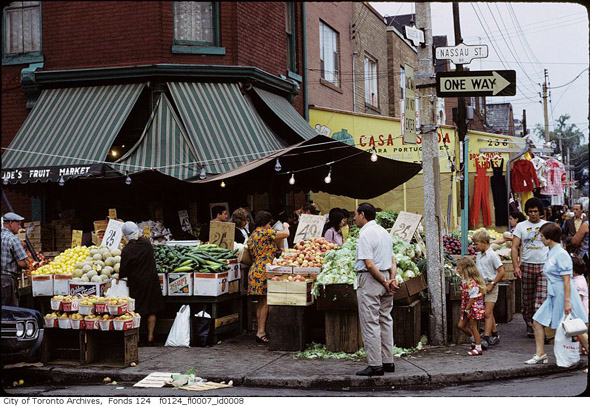 With another Pedestrian Sunday set to to take place in Kensington Market this weekend, I figure it's about time that the area be featured in one of our historical photo posts. Despite the fact that there are precious few photos in the Toronto Archives that depict market life prior to the 1970s, it is nevertheless possible to get a sense for how the neighbourhood developed into the lively destination that it is today.
With another Pedestrian Sunday set to to take place in Kensington Market this weekend, I figure it's about time that the area be featured in one of our historical photo posts. Despite the fact that there are precious few photos in the Toronto Archives that depict market life prior to the 1970s, it is nevertheless possible to get a sense for how the neighbourhood developed into the lively destination that it is today.
Prior to the first World War, Kensington had yet to develop into the full-blown outdoor market scene that it has since become. The growth of the Jewish community during the inter-war years would, however, change the area from a tired residential neighbourhood, to a burgeoning marketplace — first via handcarts pushed through the streets, and then by stalls opened up on residents' front lawns.
By the 1930s, roughly 80 per cent of Toronto's over 40,000 Jews called the Kensington Market area home, and a bustling outdoor market had already taken hold on streets like Kensington and Baldwin. As the photos below indicate, houses were small and the conditions were decidedly working class, but the market itself was vibrant and led many to acquire enough wealth to move to more affluent areas to the northwest in the years that followed.
Following World War II, much of the Jewish population had left the market, to be replaced by diverse mix of new immigrants that included Portuguese, Hungarians, Italians and Ukrainians. This saw the full-scale rise of the market atmosphere on Augusta and Nassau, where it was common to see live chickens outside the storefronts. In the years that have followed, the market has remained one of the city's most diverse places with the rise of the Asian population as well as Latin Americans and a host of other groups.
PHOTOS
1910s




1930s





1940s



1950s

1960s



1970s





1980s


1990s

 Photo from the Toronto Archives unless otherwise noted
Photo from the Toronto Archives unless otherwise noted
No comments:
Post a Comment